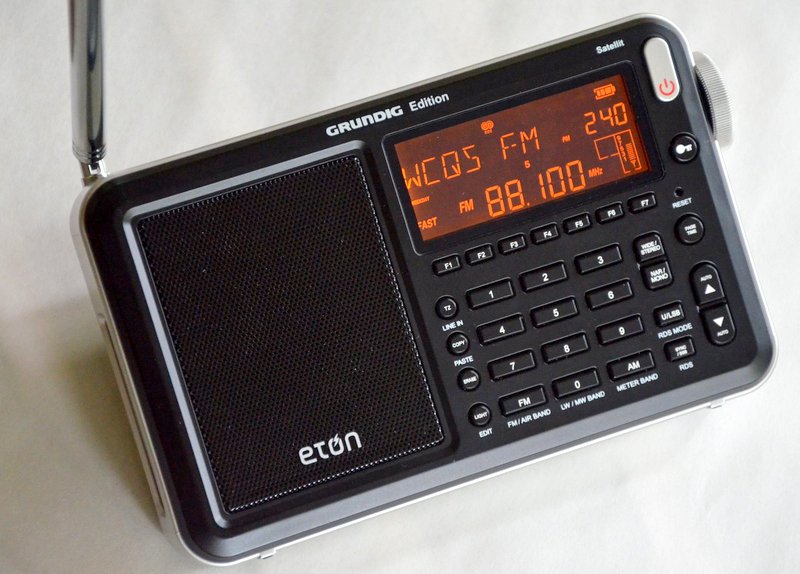Many thanks to SWLing Post contributor, Ivan Cholakov (NO2CW), who writes:
Last week I took an Eton Satellit with me on a flight from Tampa, Florida to Washington DC. The radio is very light, portable and packed with features. I have used an SDR radio before for inlight FM reception where I recorded audio, but this time I decided to only count stations with an RDS lock. With so many signals battling RDS is tricky to catch as every 10 seconds or so one station comes on top of another. The flight was just short of 2 hours and I divided my logs into three 30 minute segments. Not suprisingly looking into the technicalities I noticed RDS is commonly received from stations 50 -100 kW of power and tall towers.
Interestingly signals seem to be stronger a lower altitudes. My theory is that FM broadcast antennas heavily favor gain on the horizontal plane parallel to the terrain and send as little signal as possible out into space. I overlaid my logs onto three maps and also a video:
Click here to view on YouTube.
Impressive Ivan! I’m taking a flight later this month and might even try this with the FM radio built into my Moto G6 smart phone which also includes RDS (although I doubt reception can match that of the Satellit.
This is fascinating, Ivan! Thank you for sharing.


Unfortunately you won’t be able to use the FM radio feature built into any smartphone whilst that phone is in flight mode. Even though wifi and bluetooth are allowed to be used in flight mode, FM radio is blocked.
I also like listening to FM radio while flying. I use a Sangean DT-120 or Sangean DT-210 (small pocket digital receivers with great reception) and find the symphonized in ear headphones make great FM antennas (and they are cheap for in ear monitors with fantastic sound quality)
I’ve never had any problems flying around Australia doing this, and it’s not like I hide the radio either.
If you are concerned that this activity is not allowed in flight, please consult the list of approved electronics devices:
https://www.delta.com/content/www/en_US/support/faqs/during-your-trip/personal-electronic-devices.html
I thought I would clarify to make sure rules are followed where rules exist
Thank, Ivan. I hope all the other airlines follow Delta’s example!
Dan…
Jake and Jim are right. I know of no airline that allows use of a radio receiver during the flight. There is always a danger that that receiver will emit spurious signals that could interfere with voice communications or navigation. If you want to operate a radio from high altitude, learn to fly, charter a jet, or climb a mountain!
I love listening to FM radio when flying. My love for radio actually wins out over my anxiety of flying LOL. I find after many flights and using several different radio options that less ends up actually being more. I actually get my best results from a 2010 Sony MP3 player that has a really good FM tuner and just the standard headphone wire for antenna. It is also very neat to see how the curvature of the earth place into where you receive signals from. For example if you are flying over Dallas Texas at an altitude of 35,000 feet and you are on the northern side of the airplane chances are you are listening to Oklahoma City. The other variable that can really add some excitement to the trip is tropospheric ducting. I had a trip last year for example where I was flying west towards California and while over Texas I was hearing stations from Saskatchewan. Another time I was flying east to Tampa and once I got just to the east of Houston I hit another ducting event over the golf and ended up hearing 102.1 from Havana Cuba. That time I knew right away what the station was because it was the FM signal of AM530 that you can hear in a big chunk of Florida.
I hope you were not flying on Southwest Airlines because they prohibit the use of radio receivers on all flights. It is in writing in their complementary travel magazine.
Check with the flight crew first. No, really, I mean it. Southwest Airlines, in particular, has a rule against using portable radios in flight.
FM radios with 10.7 MHz IF strips are actually a known cause of interference in aviation radios. Do the math and you’ll notice that the LO is right there in the middle of the Aviation navigation beacon band. While it is unlikely to cause immediate problems with the airliner’s navigation, it can cause confusion on the flight deck.
I say this as an instrument rated private pilot and as a registered professional engineer. Please DON’T do this without the full knowledge and consent of the flight crew.
Jake,
The problem with this suggestion is company policy. As far as I know, no airline allows the use of a receiver or transceiver during a flight. So, asking permission from the pilot only risks getting you and them in big trouble. Leave those radios off when in the air!
Dan…
VR2HF